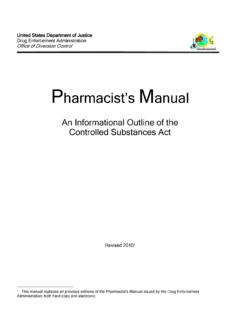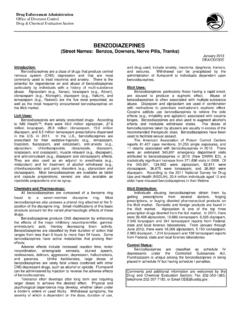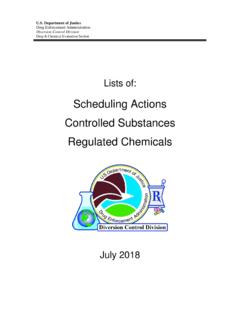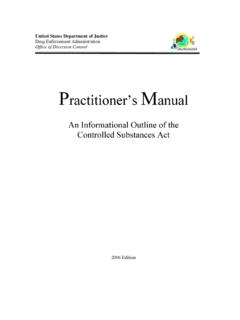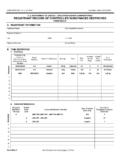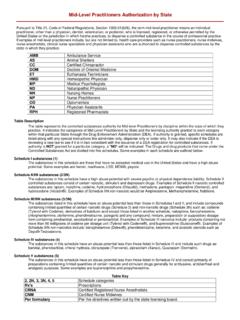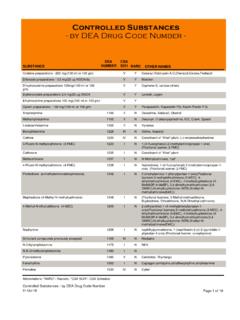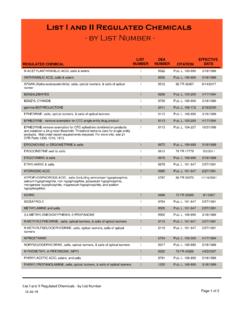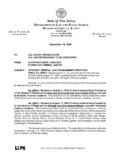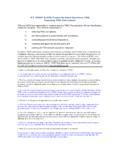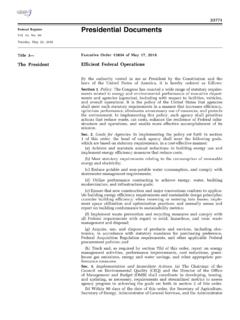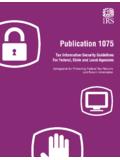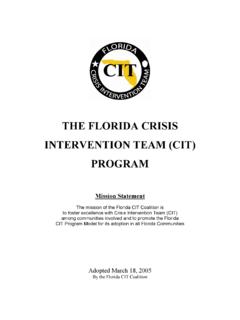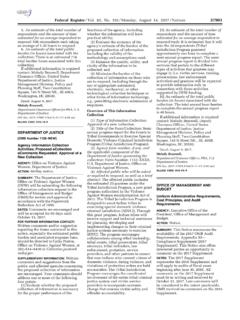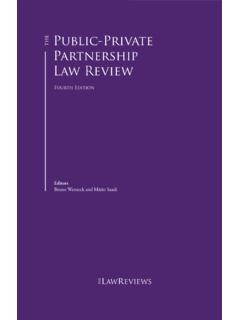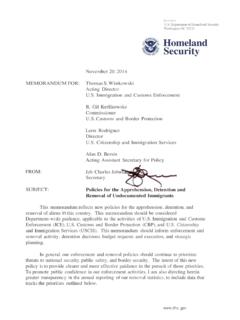Transcription of Department of Justice - deadiversion.usdoj.gov
1 Vol. 79 Tuesday, No. 174 September 9, 2014 Part II Department of Justice Drug enforcement Administration 21 CFR Parts 1300, 1301, 1304, et al. Disposal of Controlled Substances; Final Rule VerDate Mar<15>2010 19:16 Sep 08, 2014 Jkt 232001 PO 00000 Frm 00001 Fmt 4717 Sfmt 4717 E:\FR\FM\ 09 SER2tkelley on DSK3 SPTVN1 PROD with RULES253520 federal Register/ Vol. 79, No. 174 / Tuesday, September 9, 2014 / Rules and Regulations Department OF Justice Drug enforcement Administration 21 CFR Parts 1300, 1301, 1304, 1305, 1307, and 1317 [Docket No. DEA 316] RIN 1117 AB18 Disposal of Controlled Substances AGENCY: Drug enforcement Administration (DEA), Department of Justice . ACTION: Final rule. SUMMARY: This rule governs the secure disposal of controlled substances by registrants and ultimate users.
2 These regulations will implement the Secure and Responsible Drug Disposal Act of 2010 by expanding the options available to collect controlled substances from ultimate users for the purpose of disposal, including: Take-back events, mail-back programs, and collection receptacle locations. These regulations contain specific language allowing law enforcement to voluntarily continue to conduct take-back events, administer mail-back programs, and maintain collection receptacles. These regulations will allow authorized manufacturers, distributors, reverse distributors, narcotic treatment programs (NTPs), hospitals/clinics with an on-site pharmacy, and retail pharmacies to voluntarily administer mail-back programs and maintain collection receptacles. In addition, this rule expands the authority of authorized hospitals/clinics and retail pharmacies to voluntarily maintain collection receptacles at long-term care facilities.
3 This rule also reorganizes and consolidates previously existing regulations on disposal, including the role of reverse distributors. DATES: Effective Date: This rule is effective October 9, 2014. Compliance Date: All Memoranda of Agreement (MOAs) and Memoranda of Understanding (MOUs) issued pursuant to current 21 CFR will not be effective after October 9, 2014. Registrants may consult (a)(5) for information on requesting new MOAs and MOUs for disposal of controlled substances. FOR FURTHER INFORMATION CONTACT: Imelda L. Paredes, Office of Diversion Control, Drug enforcement Administration; Mailing Address: 8701 Morrissette Drive, Springfield, Virginia 22152; Telephone: (202) 598 6812. SUPPLEMENTARY INFORMATION: Outline I. Executive Summary A. Purpose of the Regulatory Action B. Summary of the Major Provisions of the Regulatory Action C. Summary of Changes in the Final Rule II.
4 Background and Legal Authority III. Discussion of Comments A. Support for the Proposed Rule (1 Issue) B. Definitions and Terms (12 Issues) C. Types of Entities That May Operate a Collection Program (9 Issues) D. Locations Where Authorized Collectors May Maintain Collection Receptacles or Host Take-Back Events (1 Issue) E. Registration Requirements for Authorized Collectors (5 Issues) F. Law enforcement (7 Issues) G. Collection Receptacle Design, Inner Liners, Placement, and Security (24 Issues) H. Mail-Back Programs (11 Issues) I. Take-Back Events (6 Issues) J. Prohibition on Handling, Sorting, and Inventorying Inner Liner Contents and Mail-Back Package Contents (8 Issues) K. Long-Term Care Facilities (LTCFs) (21 Issues) L. Disposing on Behalf of Ultimate Users (Other than Residents of LTCFs) (3 Issues) M. Registrant Return, Recall, and Transfer (3 Issues) N.
5 Destruction (19 Issues) O. Economic Concerns (18 Issues) P. Recordkeeping and Reporting (8 Issues) Q. Hazardous Materials Transportation and Hazardous Waste Destruction (3 Issues) R. Transporting Collected Substances (3 Issues) S. Miscellaneous Comments (2 Issues) IV. Regulatory Analyses I. Executive Summary A. Purpose of the Regulatory Action On October 12, 2010, the Secure and Responsible Drug Disposal Act of 2010 (Disposal Act) was enacted (Pub. L. 111 273, 124 Stat. 2858). Before the Disposal Act, ultimate users who wanted to dispose of unused, unwanted, or expired pharmaceutical controlled substances had limited disposal options. The Controlled Substances Act (CSA) only permitted ultimate users to destroy those substances themselves ( , by flushing or discarding), surrender them to law enforcement , or seek assistance from the United States Drug enforcement Administration (DEA).
6 These restrictions resulted in the accumulation of pharmaceutical controlled substances in household medicine cabinets that were available for abuse, misuse, diversion, and accidental ingestion. The Disposal Act amended the CSA to authorize ultimate users to deliver their pharmaceutical controlled substances to another person for the purpose of disposal in accordance with regulations promulgated by the Attorney General. 21 822(g), 828(b)(3). This final rule implements regulations that expand the entities to which ultimate users may transfer unused, unwanted, or expired pharmaceutical controlled substances for the purpose of disposal, as well as the methods by which such pharmaceutical controlled substances may be collected. Specified entities may voluntarily administer any of the authorized collection methods in accordance with these regulations.
7 B. Summary of the Major Provisions of the Regulatory Action The DEA is implementing new regulations for the disposal of pharmaceutical controlled substances by ultimate users in accordance with the Disposal Act. In drafting the implementing regulations, the DEA considered the public health and safety, ease and cost of program implementation, and participation by various communities. To this end, the DEA found that in order to properly address the disposal of controlled substances by ultimate users, it was necessary to conduct a comprehensive review of DEA policies and regulations related to each element of the disposal process, including the transfer, delivery, collection, destruction, return, and recall of controlled substances, by both registrants and non-registrants ( , ultimate users). The reverse distributor registration category, which is pertinent to the process of registrant disposal, was included in this comprehensive review.
8 These regulations are incorporated into a new part 1317 on disposal. Definitions relating to the disposal of controlled substances are added to (b), including definitions for employee, law enforcement officer, non- retrievable, and on-site and definitions relating to controlled substances generally are revised or added to The goal of this new part on disposal, consistent with Congress s goal in the Disposal Act, is to set parameters for controlled substance diversion prevention that will encourage public and private entities to develop a variety of methods for collecting and destroying pharmaceutical controlled substances in a secure, convenient, and responsible manner. Also, consistent with the Disposal Act s goal to decrease the amount of pharmaceutical controlled substances introduced into the environment, particularly into the water, these regulations provide individuals with various additional options to dispose of their unwanted or unused pharmaceutical controlled substances beyond discarding or VerDate Mar<15>2010 18:15 Sep 08, 2014 Jkt 232001 PO 00000 Frm 00002 Fmt 4701 Sfmt 4700 E:\FR\FM\ 09 SER2tkelley on DSK3 SPTVN1 PROD with RULES253521 federal Register/ Vol.
9 79, No. 174 / Tuesday, September 9, 2014 / Rules and Regulations flushing the substances. As a result of these regulations, the DEA hopes that the supply of unused pharmaceutical controlled substances in the home will decrease, thereby reducing the risk of diversion or harm. Ultimate User Disposal An ultimate user is defined by the CSA as a person who has lawfully obtained, and who possesses, a controlled substance for his own use or for the use of a member of his household or for an animal owned by him or by a member of his household. 21 802(27). This rule provides three voluntary options for ultimate user disposal: (1) Take-back events, (2) mail- back programs, and (3) collection receptacles. Individuals lawfully entitled to dispose of an ultimate user decedent s property are authorized to dispose of the ultimate user s pharmaceutical controlled substances by utilizing any of the three disposal options.
10 All of the collection methods are voluntary and no person is required to establish or operate a disposal program. The rule also does not require ultimate users to utilize any of these three methods for disposal of controlled substances. Although the three methods of disposal allowed by this rule seek to help protect the environment and prevent controlled substances from being diverted to illicit uses, this rule does not prohibit ultimate users from using existing lawful methods. The DEA regulations provide specific language that will continue to allow federal , State, tribal, and local law enforcement to maintain collection receptacles at the law enforcement s physical location; and either independently or in partnership with private entities or community groups, to voluntarily hold take-back events and administer mail-back programs. 21 CFR Thus, ultimate users will continue to be able to surrender their unwanted pharmaceutical controlled substances to law enforcement .
